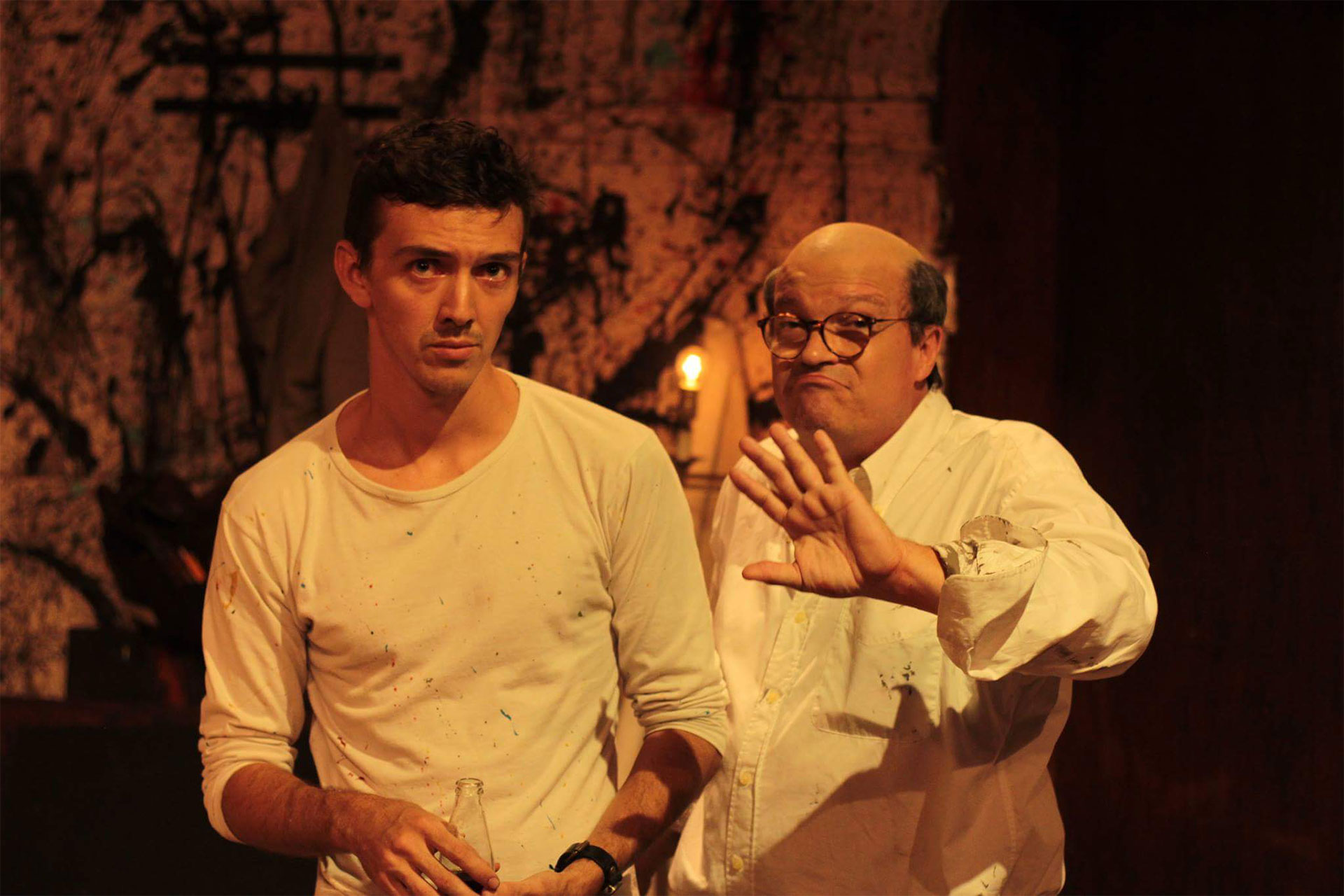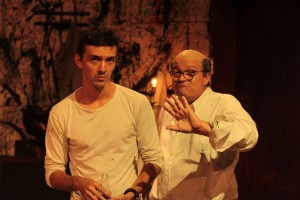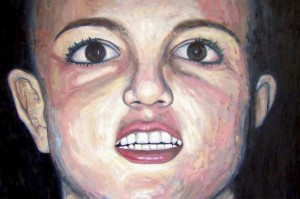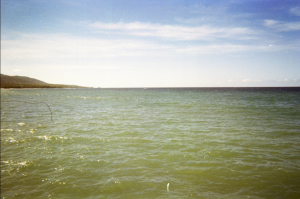Red (2009), a play by American writer John Logan, premiered in Caracas with performances by Basilio Álvarez and Gabriel Agüero, under the direction of this server. It was part of the selection of plays presented in the 2nd Festival of Contemporary North American Theater between June 10 and September 25, 2016, in the spaces of La Caja de Fósforos (the Box of Matches), at the Concha Acústica de Bello Monte.
I
The anecdote is well-known in the world of the arts: New York, 1958. Mark Rothko is commissioned by the architect Philip Johnson to make a mural inside the Four Seasons restaurant, located in the Seagram tower. Rothko accepts the assignment and begins to work on the composition of each of these paintings. Two years later, Johnson gets a call. On the other side of the line, a negative. Rothko has decided to reject the significant sum of $ 35,000, keep the work to himself, and not be exposed at the summit of capitalism.
One day, actor Orlando Arocha called to tell me that Red had been one of the works selected for the festival, and wanted to know if I was interested in directing it. Since I lost my first job at age fifteen I never wanted to feel loss again, so I adapted to receive bad news and good news with the same serenity. I discovered it the day my father died. I confirmed it in a general rehearsal where they contacted me to tell me –mistakenly– that my mother had suffered a heart attack. Or when the lead of a play I directed did suffer a heart attack and at the same time my girlfriend called to give me the news that our relationship had come to an end. Life has taught me that everything revolves, everything is full of coincidences, and this country, especially, has taught me that anything, at any moment, can be a misfortune or a joy. In an act of detachment, I had played my cards another way; it is a folly that identifies me: I take the opposite. In the stage-theater workshop with Arocha, I never gave a hint of wanting to direct Red; on the contrary, I was struck by the complex beauty that appeared in another text that I had found before. So, my response to Arocha was a sincere thanks. Then he explained to me the steps to follow from there, and, right after the call, I began to work.
II
Rothko has not been able to embrace his tragedy even though he thinks he is living it to the fullest. He is consumed by an imaginary reality, and is unable to contemplate without arrogance the changes of the world, represented in the text by the rise of painters like Picasso, Warhol or Lichtenstein, and questioned from the most classic vision through the art of Goya, Turner, and Matisse. The arrival of Ken, his assistant, allows us to hear a new voice, young, and with certain objectivity. But like every hermit, Rothko rejects in advance the new thought, and assumes the truth of his imaginary as universal truth: an intuited truth that only promotes the ability to see the world from the horror and absurdity of the human condition, but also, from the individualization of Rothko, veers the most assertive reading of the symbol for its real understanding. This creative rupture motivated by the transit of art in history leads Ken to make an appropriate comparison that is maintained throughout the work and allows the ideological battle between the characters. Ken assumes Pollock as opposed to Rothko:
KEN: Dionysius is the god of wine and excess; of movement, of transformation. That is Pollock: wild, rebellious, drunk and unbridled. Pure experience … Apollo is the god of order, of method, of limit. That is Rothko: intellectual, rabbinical, sober and moderate. Pure experience transformed by contemplation. He sprinkles paint, you study it … He is Dionysius and you Apollo.
This reading of both codes that the apprentice makes about his teacher made me think of one thing: Doesn’t Rothko splash paint too? There is debauchery in Pollock by the, apparently irrational, act of impacting paint on the canvas, but debauchery with study leads to the expected objective. If in Rothko there’s debauchery for painting from the methodological in extreme, where is the trail of painting, that passion that at first glance is not seen in his pictures? Remember that in his time, the art of Rothko was appreciated as merely decorative. And don’t get me wrong, the passion in Rothko is born through the almost ceremonial contemplation of observation, something that distances it from the drunkenness and the results obtained by Pollock.
 Basilio Álvarez, playing the role of Mark Rothko. Photo: Daniel Dannery.
Basilio Álvarez, playing the role of Mark Rothko. Photo: Daniel Dannery.
III
This montage was the rite of passage I needed to finally understand that in the depths of my being I was not wrong, that the mistakes had been worth it and that not all the whims have to be fulfilled. I do not know if I expected it to work out. During these years I have faced all kinds of reactions from the public (like any other person who does theater) and this was a slow piece, or at least I perceived it that way. Such a small space confronted the viewer to get involved in the action of the characters. The distance between stage and audience was almost non-existent, as it did not meet the criteria of the way we usually think that it should be a theatrical space. But what is a theatrical space? Maybe any space where an actor can say and transmit. Thus, the spectator was an absolute witness to each of the details of an essentially hyperrealistic montage, from the role of the actor. It is not difficult to think that the closeness of the spectator nourished the interest for the narrated. Yet there were questions: will the public be able to recognize every one of the intellectual references that Logan gets fed up with in his text? And if not, how will the spectators react to them? Will the public be able to face a montage of two and a half hours? Will the public become tired of silences, of a story narrated about what is not said, and the breathing of actions?
This montage was the rite of passage I needed to finally understand that in the depths of my being I was not wrong, that the mistakes had been worth it and that not all the whims have to be fulfilled. I do not know if I expected it to work out. During these years I have faced all kinds of reactions from the public (like any other person who does theater) and this was a slow piece, or at least I perceived it that way. Such a small space confronted the viewer to get involved in the action of the characters. The distance between stage and audience was almost non-existent, as it did not meet the criteria of the way we usually think that it should be a theatrical space. But what is a theatrical space? Maybe any space where an actor can say and transmit. Thus, the spectator was an absolute witness to each of the details of an essentially hyperrealistic montage, from the role of the actor. It is not difficult to think that the closeness of the spectator nourished the interest for the narrated. Yet there were questions: will the public be able to recognize every one of the intellectual references that Logan gets fed up within his text? And if not, how will the spectators react to them? Will the public be able to face a montage of two and a half hours? Will the public become tired of silences, of a story narrated about what is not said, and the breathing of actions?
Here, my need to delve into statism was greater; Logan’s text also allowed that reading, because if two men spend their lives debating about beauty and art it’s because they have the time to do it, and have managed to isolate themselves enough to let out what they are in their deepest being. Men who think remain silent, even to respond hotly. Men who think don’t let emotion escape until the last moment, when they see no other resource than to raise their voices and reveal the structure of creation that comes from within. For me, Rothko painted on these bases, and although I never exposed it in this way in the rehearsals, the group was entering an unconscious dynamic that dragged us towards that current; you don’t often have the possibility to reflect on history, to learn to listen to it. Today, that’s a miracle. The theater is automatic, like life in general, there are those who say «if I think I’ll get depressed, so I prefer to do.»
I think the actor should take the time to live what the character deserves. To go over the emotion of the character is to believe that he does not have an internal vibration; to act is to know how to direct that force, not to force it, not to externalize it plainly so that it can be seen or heard. Basilio and Gabriel gave that kind of performance. While I was exploring the intellectual world of the work through figures such as Nietzsche, Pollock, or Matisse -–trying to understand the imagery surrounding the characters– Basilio challenged himself by giving everything and gather what was necessary, and Gabriel explored in detail the value of each gesture.
Red is the result of an alignment. Not only do Rothko and his assistant debate in a chamber piece, but the entire play exudes the need for that debate. The idea of turning the painter’s studio into a great Pollock comes from that settlement, to expose that you can be corrupted by emotions while the world you inhabit devours you.
The audience knew how to thank it. Seldom, in the midst of this desolate city, of this desolate country, does one sit down in a theater to listen to a lecture on art. It is surprising that with the Beethoven’s Opus 62 the attendants were moved in their chair watching Rothko bathed in blood. I was touched the day I first saw it, because one must keep respect and be moved by a man exhausted by thinking and seeking the truth inside.
 Gabriel Agüero, playing the role of Ken. Photo: Daniel Dannery.
Gabriel Agüero, playing the role of Ken. Photo: Daniel Dannery.
About the director:
Daniel Dannery (Caracas, 1984) holds a degree in Arts from the Universidad Central de Venezuela with a major in Cinematography. He has developed a career as theater director, actor and playwright for theater group Skena over the past 10 years.
















